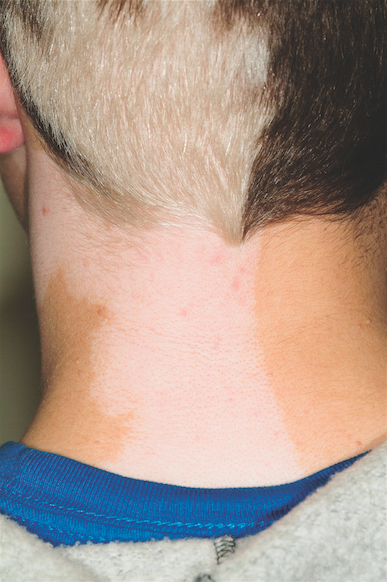User login
ANSWER
The correct answer is poliosis (choice “d”), which has been described as a reliable indicator of tuberous sclerosis when seen early in life.1 Poliosis is the specific term for focal loss of color in scalp hair. Technically, this process is a form of hypomelanosis (choice “b”), although the latter is a more generic term used to refer to loss of pigment in any area. Graying (choice “a”) usually refers to uniform loss of hair color all over the scalp—albeit with focal accentuation over the temples, as opposed to the sharply demarcated areas of complete color loss seen in poliosis. Poliosis can be seen as a feature of vitiligo (choice “c”), but the latter usually also involves pigment loss elsewhere.
DISCUSSION/TREATMENT
Poliosis, which is often idiopathic, can be seen in a number of conditions besides tuberous sclerosis and vitiligo, including halo nevi of the scalp, alopecia areata (as hair regrows), and Waardenburg’s syndrome. As mentioned above, it can appear early in life as an indicator of tuberous sclerosis, particularly when coupled with involvement of adjacent dermatomal skin. This was likely the case with this patient. No permanent treatment exists for this problem.
REFERENCE
1. Apibal Y, Reakatanan W, Chunharas A. Poliosis as the first clue of tuberous sclerosis. Pediatr Dermatol. 2008;25(4):486-487.
ANSWER
The correct answer is poliosis (choice “d”), which has been described as a reliable indicator of tuberous sclerosis when seen early in life.1 Poliosis is the specific term for focal loss of color in scalp hair. Technically, this process is a form of hypomelanosis (choice “b”), although the latter is a more generic term used to refer to loss of pigment in any area. Graying (choice “a”) usually refers to uniform loss of hair color all over the scalp—albeit with focal accentuation over the temples, as opposed to the sharply demarcated areas of complete color loss seen in poliosis. Poliosis can be seen as a feature of vitiligo (choice “c”), but the latter usually also involves pigment loss elsewhere.
DISCUSSION/TREATMENT
Poliosis, which is often idiopathic, can be seen in a number of conditions besides tuberous sclerosis and vitiligo, including halo nevi of the scalp, alopecia areata (as hair regrows), and Waardenburg’s syndrome. As mentioned above, it can appear early in life as an indicator of tuberous sclerosis, particularly when coupled with involvement of adjacent dermatomal skin. This was likely the case with this patient. No permanent treatment exists for this problem.
REFERENCE
1. Apibal Y, Reakatanan W, Chunharas A. Poliosis as the first clue of tuberous sclerosis. Pediatr Dermatol. 2008;25(4):486-487.
ANSWER
The correct answer is poliosis (choice “d”), which has been described as a reliable indicator of tuberous sclerosis when seen early in life.1 Poliosis is the specific term for focal loss of color in scalp hair. Technically, this process is a form of hypomelanosis (choice “b”), although the latter is a more generic term used to refer to loss of pigment in any area. Graying (choice “a”) usually refers to uniform loss of hair color all over the scalp—albeit with focal accentuation over the temples, as opposed to the sharply demarcated areas of complete color loss seen in poliosis. Poliosis can be seen as a feature of vitiligo (choice “c”), but the latter usually also involves pigment loss elsewhere.
DISCUSSION/TREATMENT
Poliosis, which is often idiopathic, can be seen in a number of conditions besides tuberous sclerosis and vitiligo, including halo nevi of the scalp, alopecia areata (as hair regrows), and Waardenburg’s syndrome. As mentioned above, it can appear early in life as an indicator of tuberous sclerosis, particularly when coupled with involvement of adjacent dermatomal skin. This was likely the case with this patient. No permanent treatment exists for this problem.
REFERENCE
1. Apibal Y, Reakatanan W, Chunharas A. Poliosis as the first clue of tuberous sclerosis. Pediatr Dermatol. 2008;25(4):486-487.

A 14-year-old boy presents for evaluation of a long-standing condition involving loss of pigment of the hair and the adjacent neck skin. This discoloration has been present since shortly after his birth. The patient is specifically interested in treatment options. His history includes a diagnosis of tuberous sclerosis, which he received at an early age. On examination, you note a complete loss of pigment in the posterior scalp on the patient’s left side, along with total loss of color in the skin on the adjacent part of the neck. The medial margins of both stop abruptly at midline. Additional inspection reveals several other abnormalities, including dart-shaped hypopigmented macules on the patient’s trunk, fleshy 1- to 3-mm papules clustered about the midface, and periungual fibromatous papules around several toenails.
